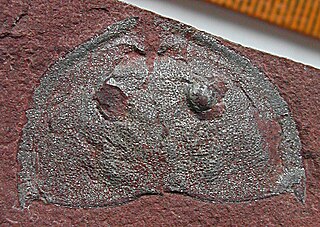The Hirnantian is the final internationally recognized stage of the Ordovician Period of the Paleozoic Era. It was of short duration, lasting about 1.4 million years, from 445.2 to 443.8 Ma. The early part of the Hirnantian was characterized by cold temperatures, major glaciation, and a severe drop in sea level. In the latter part of the Hirnantian, temperatures rose, the glaciers melted, and sea level returned to the same or to a slightly higher level than it had been prior to the glaciation.
In the geologic timescale, the Aeronian is an age of the Llandovery Epoch of the Silurian Period of the Paleozoic Era of the Phanerozoic Eon that began 440.8 ± 1.2 Ma and ended 438.5 ± 1.1 Ma. The Aeronian Age succeeds the Rhuddanian Age and precedes the Telychian Age, all in the same epoch.
The Mount Cap Formation is a geologic formation exposed in the Mackenzie Mountains, northern Canada. It was deposited in a shallow shelf setting in the late Early Cambrian, and contains an array of Burgess Shale-type microfossils that have been recovered by acid maceration.
The Williamsport Sandstone is a sandstone geologic formation in West Virginia, Virginia, Pennsylvania, and Maryland. the formation includes the Cedar Creek Limestone member. Near Cumberland, Maryland it includes the Cedar Creek Limestone member. It preserves fossils dating back to the Silurian period.
The Camp Rice Formation is a geologic formation in west Texas and southern New Mexico. It preserves fossils of the Pliocene-Pleistocene. These include the distinctive Tonuco Mountain Local Fauna.
The Troublesome Formation is a geologic formation in Colorado. It preserves fossils dating back to the Neogene period. It consists of Pale shades of pink, tan, gray, green, and white interbedded siltstone and mudstone, less abundant arkosic sandstone and conglomerate, and sparse limestone and altered crystal-vitric ash and tuff; generally poorly consolidated. It includes atypical deposits containing abundant pink, granitic cobbles and boulders along the western parts of the outcrop in the west-central and southwestern parts of the Granby Quadrangle, Fossil mammals from three sites indicate a late Oligocene age.

The Weeks Formation is a geologic formation in Utah. It preserves fossils dating back to the Cambrian period and more specifically the Guzhangian stage. Its upper part has yielded a diverse fauna dominated by trilobites and brachiopods, but also comprising various soft-bodied organisms, such as Falcatamacaris. As such, it is regarded as a Konservat-Lagerstätte.
The Sheep Pass Formation is a geologic formation in Nevada. It preserves fossils dating back to the Paleogene period.
The Juntura Formation is a geologic formation in Oregon. It preserves fossils dating back to the Neogene period.
The Tejon Formation is a Paleogene period geologic formation in California.
The Becscie Formation is a geologic formation in Quebec. It preserves fossils dating back to the early Silurian period.
The Quebec Group is a geologic group in Quebec. It preserves fossils dating back to the Silurian period.
The Forteau Formation is a geologic formation in Newfoundland and Labrador. It preserves fossils dating back to the Cambrian period.
The Disappointment Bay Formation is a geologic formation in Nunavut, extending from Ellesmere Island in the east to Bathurst Island in the west. It preserves fossils dating back to the Devonian period, primarily of invertebrates.
The Juchipila Formation is a geologic formation in Mexico. It preserves fossils dating back to the Neogene period. Closely corresponding to the other Hemphillian faunal assemblages of North America, it is significant for understanding the palaeofauna of Miocene and Pliocene central Mexico.
The Caton Shales is a geologic formation in England. It preserves fossils dating back to the Carboniferous period.
The Rhiwlas Limestone is a geologic formation in Wales. It preserves fossils dating back to the Ordovician period.
The Carmarthen Formation is a geologic formation in Wales and England. It preserves fossils dating back to the Ordovician period.
The Stockdale Shales is a geologic formation in England. It preserves fossils dating back to the Silurian period.
The Elton Beds is a geologic formation in England and Wales. It preserves fossils dating back to the Silurian period.
